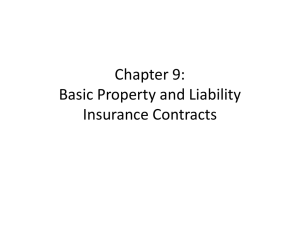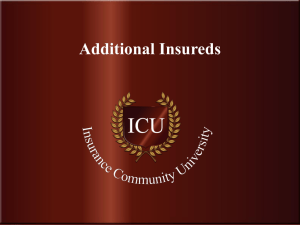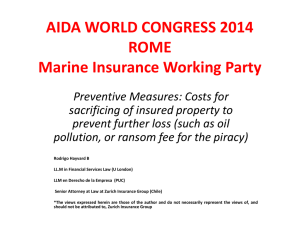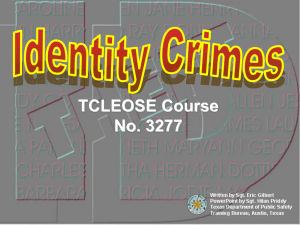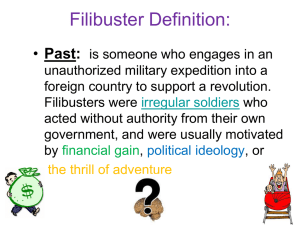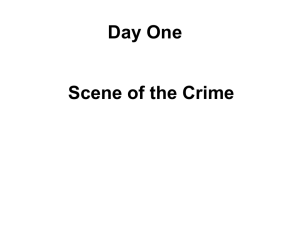Crime and Kidnap & Ransom
advertisement
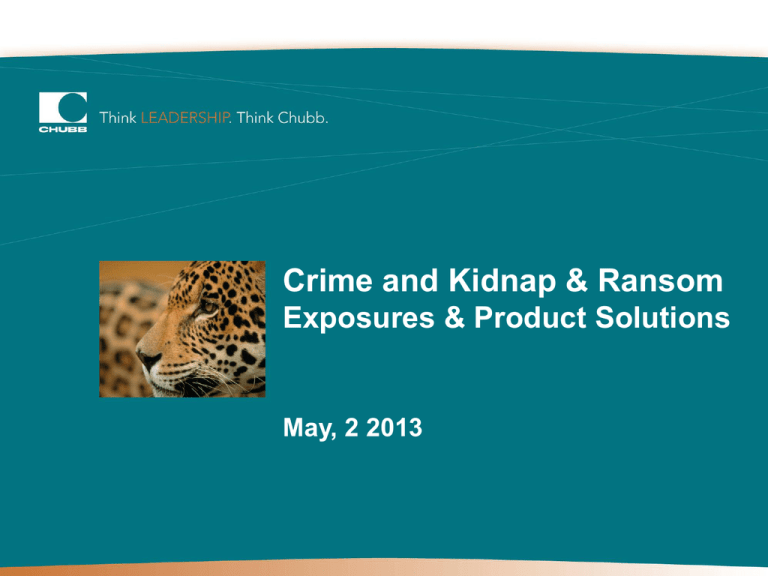
Crime and Kidnap & Ransom Exposures & Product Solutions May, 2 2013 Meet the Presenters Rob Hanson • Senior Underwriter • Crime and Kidnap & Ransom Subject Matter Expert • robhanson@chubb.com Yianni Fountas • Crime and Kidnap & Ransom Underwriter • yfountas@chubb.com 2 Crime Agenda • • • • • • History of Crime Insurance Why and How Fraud Occurs Crime Loss Statistics Areas of Exposure/Key Problem Areas Chubb’s Crime Coverage Basics - What is Covered Underwriting Considerations: – – • • • Target industry classes Red Flags Underwriting Requirements Claims Scenarios Questions 3 History of Crime Insurance • Has its roots in fidelity bonds from the early 1900s (private households) • 1930s saw the start of fidelity bonds for commercial companies • 1986 Commercial Crime Policy was born • 2000 onwards saw policy broaden out to also include • • crimes committed by non-employees • crimes committed by employees against clients Crime can be purchased on a stand-alone basis 4 Crime Risk Analysis Why Fraud Occurs 1. Opportunity 2. Motivation 3. Rationalization 5 Crime Risk Analysis Opportunity • Mergers, Acquisitions and Divestitures • Rapid Expansion • Downsizing or Financial Problems • Inadequate Supervision • Inadequate Segregation of Internal Controls • Too Much Trust 6 Crime Risk Analysis Motivation & Rationalization • Entitlement • Attitude • Downsizing • Poor Moral • Personal Problems • Societal Values 7 Impact of the Economic Crisis • Fraud by long-term employees is increasing: Employees who have worked at company – >5 years account for 66% of total losses 1 – >10 years account for 33% of losses 1 • Fraud committed by employees acting in collusion surged from 32% in 2007 to 61% in 2011 1 • Collusion leads to larger losses – median loss in collusion schemes is $250K vs. $100K for single perpetrator schemes 2 1. KPMG 2011 Report 2. Association of Certified Fraud Examiners 2012 Report 8 Smaller Companies Are at Greater Risk • Weaker internal fraud controls cause greater vulnerability to crime losses • 32% of frauds against small businesses (<100 EEs) – Highest rate of any category – Median loss for fraud $147K • Private company fraud rate and median loss are higher than for public company – Fraud rate: 39% private vs. 28% public – Median loss: $200,000 private vs. $127,000 public • Frauds are more than three times as likely to be detected by accident in small companies (<100 EEs) versus mid to large size companies (100+ EEs) – 13% small vs. 4% mid to large size Source: Association of Certified Fraud Examiners (2012) 9 Market Loss Ratios and Premiums • Average loss ratio of all Fidelity Bond writers increased four out of five years from 2006 to 2011 • While the 45.8% overall average loss ratio of all writers of Fidelity Bonds in 2011 was lower than the loss ratios in 2009 and 2010, those years were far above historical norms. In comparison with the 36.2% loss ratio in 2006, the 2011 loss ratio was 27% higher. • Total written premium for all writers decreased 12.2% from 2006 to 2011 10 Areas of Exposure/Key Problem Areas • Vendor Schemes • Fictitious vendors • Actual vendors • Inventory Theft • Payroll Theft • Ghost Employees • Manipulation of direct deposits • Unauthorized bonus/salary increases • Theft of Cash • Accounts Receivable • Petty Cash • Checks payable to employee or relative 11 Chubb’s Product Solutions • For a 7th straight year, Chubb has been named the #1 Fidelity writer (defined as Commercial Crime and Financial Fidelity) in North America, by the Surety & Fidelity Association of America. • Worldwide Commercial Crime GWP = $223M. • Canadian Commercial Crime GWP = $13M. 770 different customers. 12 Crime: What is Covered: Loss Sustained Form • The Crime policy provides coverage for Prior Losses and Non Accumulation of limits • Coverage is in place from the time the loss was sustained • There is no aggregate, limit is per loss only 13 Crime: What is Covered: Insuring Clause 1: 1. Employee Theft, DIRECT LOSS 2. Premise Coverage, DESTRUCTION & DISAPEARANCE OF MONEY AND SECURITIES, resulting from safe burglary or robbery 3. Transit Coverage, DESTRUCTION & DISAPEARANCE OF MONEY AND SECURITIES, resulting from robbery (physical force) 4. Forgery 5. Fraud Transfer Fraud 6. Money Orders and Counterfeit Currency 7. Credit Card Fraud 8. Computer Fraud • ** the loss is sustained by the insured organization 14 Crime: What is Covered: Insuring Clause 2: Client Coverage – Chubb Selling Feature** • The Company shall pay the Insured for direct loss sustained by a Client resulting from Crime by an Employee not in collusion with such Client’s employees. *the loss is sustained by a client of the insured organization **this is also a significant extension to the minimal Crime coverage offered on a standard GL form (which does NOT offer third party Client coverage) 15 Crime: What is Covered: Insuring Clause 3: Employee Benefit Plan Coverage • Provides coverage for loss of an Employee Benefit Plan resulting from Crime committed by an Employee, fiduciary, trustree, administrator or employee of the plan ** the loss is sustained by the insured organization 16 Crime: What is Covered: Insuring Clause 4: Expense Coverage • Chubb will provide expense coverage to help determine the scope of a loss or help to get company back to a level of service it was before the loss. Sublimit normally below $250,000 with no deductible. 17 Key Exclusions • Trading Exclusion – not insuring ‘bets’ • Trade securities, confidential information – intangible so impossible to attach value • Partner of Insured – can’t steal from Yourself & get paid back • War Exclusion • Loss of Income – direct loss covered only • Prior Knowledge – Once someone is known as a “thief” no more coverage • Extortion – covered under K&R policy 18 Underwriting Considerations • What is the nature of the business? • What does this company own, assets? • How much product does the company sell, revenues? • What are the internal controls like to minimize theft? • How many employees are there? • How many locations are there, where and what kind (ie: warehouse, retail, sales) • What is the company’s loss history? 19 Underwriting Considerations Common Red Flags – High Risk • Frequency of small claims • Lack on external and/or internal audit • Outsourced IT, Accounting, Payroll, HR • Lack of background or reference checks on employees • No separation of duties 20 Underwriting Considerations Positive Elements – Good Risk • Written Code of Ethics • Master Vendor List • Segregation of duties • Competitive bidding procedures • Counter-signature on checks • Dual control/authorization on wire transfers 21 Target Classes: Target Classes – lower exposure: • Not for Profits • General business services • Law firms, with no client escrow account exposure • Real estate owners and managers • Recreation and amusement firms Target Classes – medium to higher exposure • Wholesale trade, non-durable goods (with short shelf lives or are consumable) • Hotels • Property managers (building management) • Temporary staffing and employment agencies • Retail sales Target classes – high exposure (case-by-case basis, very careful underwriting required) • Law firms, with significant client escrow account exposure • Gas stations • Trucking and motor freight transportation • Car dealerships • Vices” such as beer, wine, liquor, or cigarettes in any form (wholesale, retail, distribution, manufacturing) • Jewelry stores, only written if they carry “Jeweler’s Block” coverage • Companies that use precious metals in their manufacturing processes • Businesses with significant amounts of cash on premises, including casinos and gaming operations 22 Restricted Classes: • • • • • • • • • • • • Financially distressed companies “Roll Up” firms Lease financing operations Third Party Administrators Trade Unions, other than for ERISA Bonds only Jewelry stores that do not carry “Jeweler’s Block” coverage Museums, unless coverage for artwork is excluded (normally covered by an Inland Marine policy) Escrow agents and 1031 exchanges Armored car companies and Cash in Transit firms Title insurance agents and brokers Financial firms, including REITS (refer to DFI ) Currency exchanges 23 Crime Claims Scenarios Example #1 • Annual revenues of $25M; 200 employees • Cause of Action – Employee Theft (Phantom Vendor) • A communications firm’s human resources manager recommended that her company hire an outside accountant to attempt to reduce the company’s modifier on workers’ compensation claims, thereby reducing payments. Senior management approved the HR manager’s suggestion and even publicly congratulated her for her money-saving idea. The HR manager then set up a phony consulting firm and billed the company for this and other consulting services that were never provided. The HR manager’s actions went undetected for more than two years, until the accounting staff began questioning the billing amounts. • An audit determined that the manager had stolen more than $500,000. 24 Crime Claims Scenarios Example #3 • Annual revenues of $10M; 500 employees • Cause of Action – Employee Theft (Inventory) • A manager of a wholesale paper products distributor colluded with a fellow employee in the warehouse to manipulate inventory and defraud the company. The pair stole from the company by diverting raw material before it became inventory and by selling rolls of paper and other finished products. An anonymous tip regarding the theft resulted in the company hiring a private investigator. The private investigator uncovered the scheme and determined that it had been taking place for nearly two years. • The total loss to the distributor exceeded $1.5 million. 25 Crime Claims Scenarios Example #2 • Annual revenues of $100M; 200 employees • Cause of Action – Employee Theft (Payroll) • The payroll clerk for a waste management firm added several relatives to the payroll. He faithfully deposited paychecks into the phony employees’ bank accounts for nearly three years before he left the company and the new payroll clerk discovered the scheme. • The company determined that the crooked clerk had made phony payroll payments totaling more than $300,000 to his relatives. 26 Crime Questions??? 27 Kidnap & Ransom Agenda: • History of Kidnap & Ransom Insurance • K&R Coverage Basics • The Ackerman Group • RiskNet • Underwriting Considerations • Questions 28 History of K&R • Concept originated in London • At one time, both personal and corporate policies • Chubb has written K&R policies for over 30 years • have partnered with the Ackerman Group since 1978 • Worldwide Chubb GWP = $26.6M • Current Canadian K&R book = $1.6M. 275 total policies. • Can offer on a stand-alone basis. No existing Chubb relationship required. 29 History of K&R • Kidnapping - It’s a business • Terrorist Groups - source of income • Motivation + Opportunity- The perfect crime • Corporate deep pockets • Worldwide economic disparity 30 History of K&R Prevention • Research - Has the Department of Foreign Affairs issued a warning? • Educate - Ensure that travelling employees are aware of the travel policy - who to call etc. • Travel Planning – • - What NOT to pack/ Local travel precautions Management Crisis Planning – Ackerman Group provides corporate sessions and advice! 31 K&R Basics: • No Aggregate • Reimbursement basis • Broad Definition of Insured Persons • Multiple Insuring Clauses 32 K&R Basics: Insured Person: • All directors, officers and Employees of an Insured and: - any person residing or visiting in their home; - all of their Relatives; - any guest of customer traveling with them or on the Insured’s Premises; or - Any consultant who is a natural person and is performing services for an Insured 33 K&R Basics: Insuring Clauses: 1. Kidnapping Coverage 2. Threat Coverage 3. Delivery Coverage 4. Expense Coverage 5. Emergency Political Repatriation Coverage – Unique to Chubb 6. Accidental Loss Coverage 7. Legal Liability Coverage 34 K&R Basics: Important Definitions: • Kidnapping: o • Threat : – • Threat means a declaration with or without a demand, of an intention or determination to injure or harm an Insured, an Insured’s property, an Insured Person or an Insured Person’s property by commission of an unlawful act. Threat does not include Workplace Violence or Stalking Threat. Emergency Political Repatriation Coverage: – • Kidnapping or Kidnapped means an actual or alleged wrongful taking of an Insured Person that includes a demand for payment by an Insured or an Insured Person in exchange for the release of such Insured Person. Emergency Political Repatriation means the return of an Insured Person to the Resident Country Accidental Loss: o Accidental Loss means Loss of Life, Loss of Use, Loss of Sight, Loss of Speech and/or Hearing, or Mutilation of an Insured Person 35 K&R Basics: Expense: • • • • • • • • • • • • • • • • Reasonable fees and expenses including: an independent security consultant; an independent public relations consultant; travel and accommodations of an Insured Person; independent legal advice; independent security guard services up to fifteen (15) days; advertising, communications and recording equipment; an independent forensic analyst; assessment of the Threat by an independent security consultant; interest for a loan taken by an Insured for property or other consideration surrendered as payment under Insuring Clauses 1 or 2; a reward paid by an Insured the Salary which an Insured continues to pay an Employee who is Kidnapped or Detained. the salary or wages which an Insured pays a newly hired natural person to conduct the duties of an Employee who is Kidnapped or Detained consequential personal financial loss reasonable medical, cosmetic, psychiatric and dental expenses incurred following the Insured Person’s release reasonable expenses of rest and rehabilitation, including meals and recreation, for up to thirty (30) days 36 K&R Enhancement Endorsement • Broad Hijaking Coverage • Retraining Expenses • “Express” Kidnapping ($100K sublimit) • Disappearance investigation • Business Income extension • Amended ‘Detention’ Exclusion • Deletes War Zone Exclusion • Clarifies Emergency Political Repatriation coverage • Threat Response Coverage ($250K) • Corporate Child Abduction Expense Coverage with Sublimit • Hostage Crisis with Sublimit 37 Ackerman Group: • retained by Chubb for the past 31 years to respond to emergencies under the K&R policy • in business since 1977 providing broad range of security and investigative-related issues • staff all have previous history with CIA, FBI or military specialoperations units • have personal contacts in virtually every corner of the world and work in more than 20 languages 38 Ackerman’s Role: • Ackerman’s initial response to the call • Strategize with family and company • Liaison with local law enforcement • Negotiates with kidnappers • Ransom Drop/Hostage Recovery 39 RiskNet • Country summaries • Risk Profile • City Guidelines • Travel & Airline Guidance • News Flashes of Current Events **Insured given access to RiskNet as soon as coverage is bound with Chubb 40 Underwriting Considerations • Nature of Business, industry • Total Revenue, size of company • Number of employees • Amount of foreign travel and rating of these countries • use Ackerman website to obtain rating • if not rated by Ackerman, use foreign department websites for general information • Amount of Security and Exposure Awareness • Loss history and experience • MEXICO – Supplemental Application may be required 41 Highest Risk Countries South America Africa Middle East Mexico Venezuela Algeria Burkina Faso Mali Mauritania Nigeria Niger Somalia South Sudan Sudan Afghanistan Iran Iraq Kyrgyzstan Pakistan Syria Yemen 42 Multi-Year Deals Available: • Annual Installment Option, OR • 2.5 – 2.75 Rate Factor for 3-year deals 43 Questions?? 44
